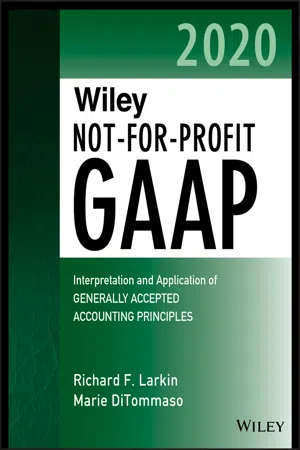
Wiley Not-for-Profit GAAP 2020
Interpretation and Application of Generally Accepted Accounting Principles
- English
- ePUB (mobile friendly)
- Available on iOS & Android
Wiley Not-for-Profit GAAP 2020
Interpretation and Application of Generally Accepted Accounting Principles
About this book
Ensure that your not-for-profit accounting is airtight for 2020
Not-for profit organizations have unique characteristics, so they must adhere to a specific set of generally accepted accounting principles (GAAP). Wiley Not-For-Profit GAAP 2020 provides practical guidance on how to identify and apply the relevant standards. This guide is indispensable for professionals responsible for preparing and auditing not-for-profit accounts. You will learn how to interpret the relevant accounting principles and how to apply them, all while minimizing unnecessary effort and eliminating potentially costly errors.
This comprehensive yet concise text thoroughly examines the latest standards for measurement, presentation, and disclosure related to not-for-profits. It covers the Financial Accounting Standards Board (FASB) Accounting Standards Codification, all relevant Accounting Standards Updates, and other guidance that applies to not-for-profit organizations, particularly that of the American Institute of Certified Public Accountants (AICPA). With this unrivalled reference tool, your not-for-profit GAAP questions are answered.
- Easily understand the latest not-for-profit GAAP with visual aids, including flowcharts, diagrams, and illustrations
- Navigate complex requirements and ensure completeness of GAAP disclosures
- Stay current with all not-for-profit accounting pronouncements, including FASB, AICPA, and more
- Enjoy practical, user-friendly guidance on applying the relevant accounting standards in your not-for-profit organization
With Wiley Not-For-Profit GAAP 2020, you can be assured you have the most current, comprehensive accounting information that applies to nonprofit organizations. Stay in compliance and ensure timely, accurate reporting with this authoritative volume.
Frequently asked questions
- Essential is ideal for learners and professionals who enjoy exploring a wide range of subjects. Access the Essential Library with 800,000+ trusted titles and best-sellers across business, personal growth, and the humanities. Includes unlimited reading time and Standard Read Aloud voice.
- Complete: Perfect for advanced learners and researchers needing full, unrestricted access. Unlock 1.4M+ books across hundreds of subjects, including academic and specialized titles. The Complete Plan also includes advanced features like Premium Read Aloud and Research Assistant.
Please note we cannot support devices running on iOS 13 and Android 7 or earlier. Learn more about using the app.
Information
PART 1
OVERVIEW OF NOT-FOR-PROFIT ORGANIZATIONS
1
OVERVIEW OF NOT-FOR-PROFIT ORGANIZATIONS
- Perspective and Issues
- Key Differences between Not-for-Profit and For-Profit Organizations
- Resource Use Consideration
- Generally Accepted Accounting Principles
PERSPECTIVE AND ISSUES
- They receive contributions from significant resource providers who do not expect a commensurate or proportionate monetary return.
- They operate for purposes other than to make a profit.
- There is an absence of ownership interests like those of business enterprises.
- Keeping financial records;
- Preparing accurate and meaningful financial statements;
- Budgeting and anticipating financial problems;
- Safeguarding and managing the organization's financial assets;
- Complying with federal and state reporting requirements.
Table of contents
- COVER
- TABLE OF CONTENTS
- PREFACE
- ABOUT THE AUTHORS
- NOT-FOR-PROFIT ACCOUNTING LITERATURE
- PART 1: OVERVIEW OF NOT-FOR-PROFIT ORGANIZATIONS
- PART 2: BASIC FINANCIAL STATEMENTS
- PART 3: SPECIFIC NOT-FOR-PROFITACCOUNTING TOPICS
- PART 4: OTHER ACCOUNTING-RELATED NOT-FOR-PROFIT TOPICS
- PART 5: GENERAL ACCOUNTING TOPICS APPLIED TO NOT-FOR-PROFIT ORGANIZATIONS
- APPENDIX: DISCLOSURE CHECKLIST
- INDEX
- END USER LICENSE AGREEMENT